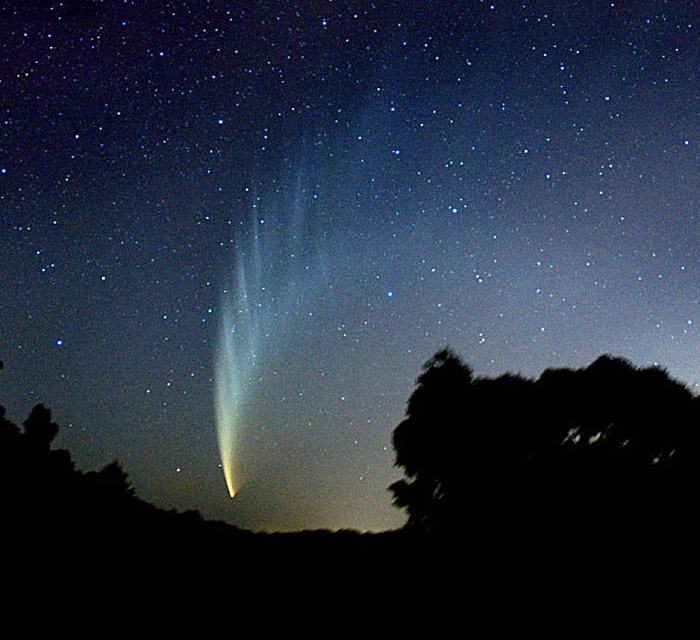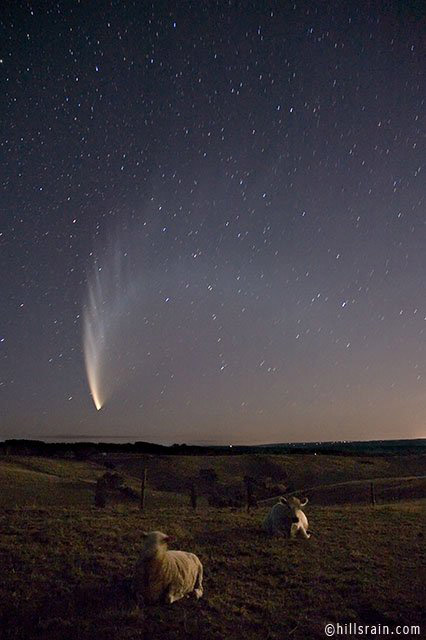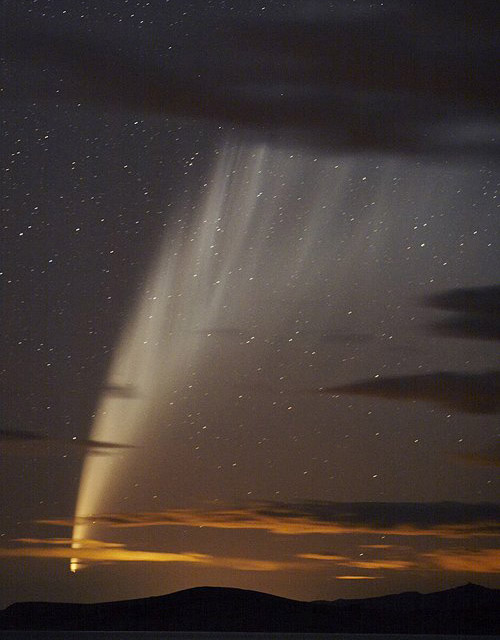
A sign in the sky, 1965
In late Oct, 1965, Br Branham preached “Power of Transformation” and “Leadership” in a trailer park, located in the small town of Prescott, AZ. While he was there, he accepted an invitation to go hunting in the vicinity. He returned to Prescott shortly thereafter to hunt with several brethren on a local ranch named Spider Ranch.
The group of hunters had a base camp set up high in elevation, above the surrounding hills. In the evening, after darkness had fell, Br Branham left the group and walked out among ancient pinion pines. He sat down alone, on a log, and remained there for some time gazing at a prominent comet that had appeared in mid Sept, and was spectacular in the clear Arizona sky.
Upon his return to camp he made this statement: “All these things have a meaning.”
Immediately the brethren asked the meaning; expecting a revelation of significance.
Br Branham solemnly told them, “That was for me,” and it was clear he had no more he was willing to say about it. Less than 2 months later, the seventh star was extinguished.

The following are a few facts about the comet of 1965:
Some of the brightest comets ever seen, including the “great” comets of 1843, 1882, and 1965, all of which were visible in broad daylight when near the sun. These comets are classified as “sungrazers,” because of their close orbit proximity to the sun.
Comet Ikeya-Seki, formally
designated C/1965 S1, 1965 VIII, and 1965f, was a comet discovered independently
by Kaoru Ikeya and Tsutomu Seki. First observed as a faint telescopic object
on September 18, 1965, the first calculations of its orbit suggested that
on October 21, it would pass just 450,000 km above the Sun's surface, and would
probably become extremely bright.
Comets can defy all predictions, but Ikeya-Seki performed as expected. As it
approached perihelion observers reported that it was clearly visible in the
daytime sky next to the Sun. In Japan, where it reached perihelion at local noon,
it was seen shining at magnitude –17, some 60 times brighter than the full Moon.
It proved to be one of the brightest comets seen in the last thousand years,
and is sometimes known as the Great Comet of 1965.
The comet was seen to break into three pieces just before its perihelion passage. The three pieces continued in almost identical orbits, and the comet re-appeared in the morning sky in late October, showing a very bright tail. By early 1966, it had faded from view as it receded into the outer solar system.
(Perihelion: the point in the orbit of a planet or comet where it is nearest to the sun)
Kreutz Sungrazers
The Kreutz Sungrazers are a family of comets characterized by orbits taking
them extremely close to the Sun at perihelion. They are believed to be fragments
of one very large comet that broke up several centuries ago and are named for
the astronomer Heinrich Kreutz, who first demonstrated that they were related.
Several members of the Kreutz family have become Great Comets, occasionally
visible near the Sun in the daytime sky. The most recent of these was Comet
Ikeya-Seki in 1965, which may have been one of the brightest comets in the last
millennium.
A comet does not give off any light of its own. What seems to be light from the comet is actually a reflection of our Sun's light. Sunlight bounces off the comet's ice particles in the same way light is reflected by a mirror.

241-2 THYATIREAN.CHURCH.AGE -
CHURCH.AGE.BOOK CPT.6
As we have already stated, Jesus identifies Himself with the messengers of each
age. They receive from Him the revelation on the Word for each period. This
Word revelation brings the elect of God out of the world and into full union
with Jesus Christ. These messengers are called stars because they shine
with a borrowed or reflected light of the Son, even Jesus. They are
also called stars because they are 'holders of light' at night. Thus in the
darkness of sin, they bring the light of God to His people.
79-2 EPHESIAN.CHURCH.AGE - CHURCH.AGE.BOOK
CPT.3
In that right hand of power are seven stars, who, according to Revelation 1:20,
are the seven church messengers. This signifies that the very power and authority
of God are behind His messengers to every age. They go forth in the fire and
power of the Holy Ghost with the Word. They are stars because they reflect light.
The light they reflect is His light. They have no light of their own.
They kindle not their own fires that men may walk in the light of their sparks.
SHALOM_ SIERRA.VISTA.AZ SUNDAY_ 64-0112
70 That sun is the Word of God. In the beginning, God
said, "Let there be light." And when the manifested Word of God, when
the Word of God was manifested, there was light. First God spoke it. What if
it didn't manifest? Then it wasn't light yet. But when He spoke it, and then
it was manifested, vindicated, His Word was a-vindicated, light come into existence.
And that's the only way it can be done now, is when the Word is vindicated,
God's written Word a-vindicated, then it shows Light. It's... A portion is lit,
or put out for each age. We found it in the church ages; we find it in the Old--the
Old Testament church ages. Each time that there come a time for a--a certain
manifestation of the journey, there was a prophet came to the earth.
And the Word came to the prophet, and he made that Word live. And when that
Word was identified, it reflected God. And
there was the--the age, there was the Light. And that's the way Light
comes today.

http://cometography.com/lcomets/1965s1.html
http://www.solarviews.com/cap/comet/ikeya.htm
..........................................................................
The following photos and information are regarding the 2007 Great Comet

Jan 15,
2007
A comet that has generated tremendous excitement the past week became visible
in broad daylight Saturday in an event that will likely be recalled as the skywatching
opportunity of a lifetime for many people.
Observers have followed its gradual brightening as its distances from Sun and Earth decreased. It's currently both a morning and evening object, visible very low near the east-southeast horizon about 30 to 40 minutes before sunrise and very low near the west-southwest horizon about 30 to 40 minutes after sunset.

SPACE.com's Skywatching Columnist Joe Rao called it "one of the
rarest of all cometary spectacles."
Comet McNaught is now the brightest comet in 40
years, according to the International Comet Quarterly at the
Harvard-Smithsonian Center for Astrophysics.
Brightest Comet since 1965
As Comet McNaught neared the Sun, more of its ice and dust was radiated off
the surface. This material reflects sunlight, giving a comet its brilliance.
McNaught has become minus 5 on
an astronomers brightness scale in which smaller numbers are brighter and negative
numbers are the brightest of all. Venus shines at minus 4, brighter than any
star. The full Moon is minus 12.7.
The only comet since 1935 to be brighter was Ikeya-Seki in 1965.
It shone at magnitude minus 7.
Comet McNaught, dazzling in pictures, is now far brighter than was the widely
seen Hale-Bopp in 1995.
Comet McNaught is named for Australian astronomer Robert McNaught, who found
it last year. The comet's evening show is nearly over for Northern Hemisphere
skywatchers now as it sets just moments after the Sun on Sunday and then ahead
of the Sun by mid-week. Beginning Sunday, skywatchers in the Southern Hemisphere
might glimpse the comet soon after local sunset.

2007 Great Comet
Soon after confirmation of the discovery, Southern hemisphere observers began following the comet to refine the description of its orbit. From August through November 2006, the comet was imaged and tracked as it moved through Ophiuchus and Scorpius, giving an estimated brightness as high as magnitude +9, still too dim to be seen with the unaided eye.[2]. Then, for most of December, the comet was lost in the glare of the sun.
Upon recovery in late December, it became apparent that the comet was brightening rapidly, reaching naked-eye visibility in early January 2007. It was visible in the northern hemisphere near Venus, in Sagittarius and surrounding constellations, until about 13 January 2007. Perihelion (closest approach to the sun) was 12 January 2007 at a distance of 0.17 AU.[3] This was close enough to the Sun to be observed by the space-based Solar and Heliospheric Observatory (SOHO). The comet entered SOHO's LASCO C3 camera's field of view 12 January 2007, and was viewable on the web in near real-time. The comet exited SOHO's field of view on 16 January 2007. Due to its proximity to the sun, the Northern Hemisphere ground-based viewers had a short window for viewing, and the comet could be spotted only during bright twilight, immediately after sunset.
As it reached perihelion on January 12, it became the brightest comet
since Comet Ikeya-Seki in 1965.[4] The comet was dubbed
the Great Comet of 2007 by Space.com.[5] On January 13 and 14,
2007, the comet attained an estimated maximum apparent magnitude of -6.0, as
reported by several observers in the Northern hemisphere.[3]
Comet McNaught in broad daylight while it was visible by naked eye. Taken on
13 January at 14:00 UTC in Gais/Switzerland.The comet was visible
in daylight about 5°- 10° southeast of the sun from January 12
to 14, with a peak brightness of magnitude -5.5.[6] Perigee (closest
approach to the Earth) was 15 January 2007, at a distance of 0.82 AU.[7]
After passing the sun, Comet McNaught became visible in the Southern hemisphere. In Australia, according to Siding Spring Observatory at Coonabarabran, where the comet was discovered, it was to have reached its theoretical peak in brightness on Sunday, 14 January 2007 just after sunset,[8] when it would have been visible for 23 minutes after sunset.[1] On 15 January 2007 the comet was observed at Perth Observatory with an estimated apparent magnitude of -4.0.[3]
References and footnotes
^ Report on the comet discovery and progress from Robert McNaught's homepage.
Retrieved on 2007-01-17.
^ Kronk's Cometography - C/2006P1. Retrieved on 2007-01-17.
^ a b c Recent Comet Brightness Estimates
^ Brightest comets seen since 1935. Harvard. Retrieved on 2007-01-12.
^ The Great Comet of 2007: Watch it on the Web Yahoo News, January by Joe Rao
of SPACE.com Skywatching Columnist. Accessed 16 January 2007
^ According to reports on spaceweather.com
^ Southern Comets Homepage. Retrieved on 2007-01-17.
^ Siding Spring Survey
^ P1 magnitude plot accessdate = 2007-01-22
^ SkyTonight.com - Comet Tail Still Visible Up North

Editor's note:
The comet appeared before sunrise in the East, It also appeared after sunset in the West. It was witnessed in the Northern Hemisphere, and then in The Southern. It was seen both in broad daylight, and in the night. Truly this was a global, universal sign in the heavens.
Luke 21:25
25 And there shall be signs in the sun, and in the moon, and in the stars;...
KJV
Another note of interest: Compare the 2007 comet's composition and overall appearance with that of the 1963 Cloud picture.
The Comet was to have reached its theoretical peak in brightness on Sunday, 14 January 2007 just after sunset, when it would have been visible for 23 minutes after sunset
The cloud remained sunlit for 28 minutes after local sunset. Iridescence was noted by many observers.
The words, “All these things have a meaning,” resound again today.